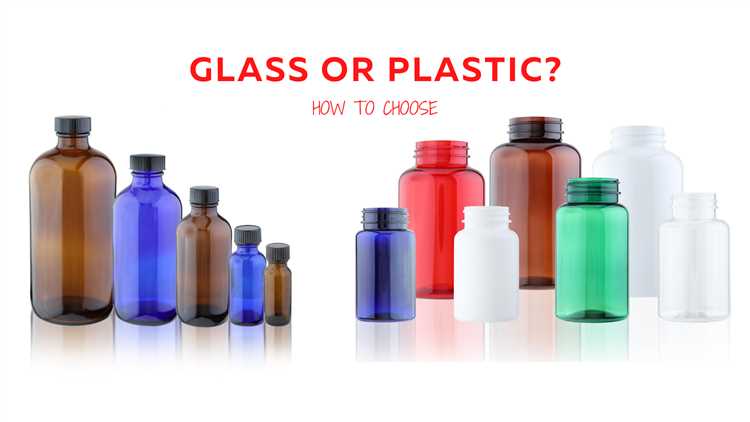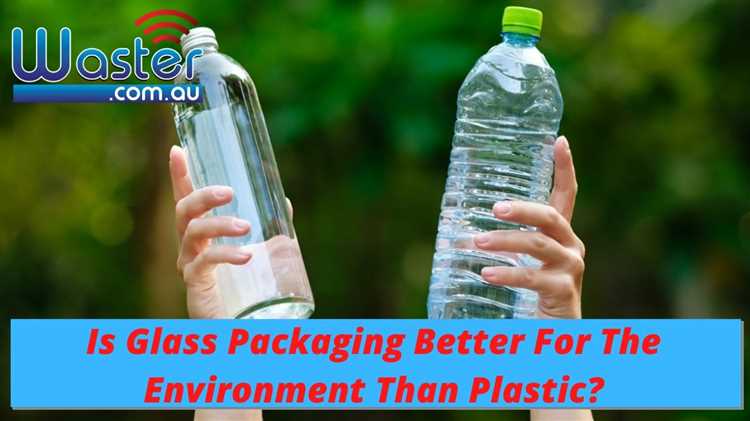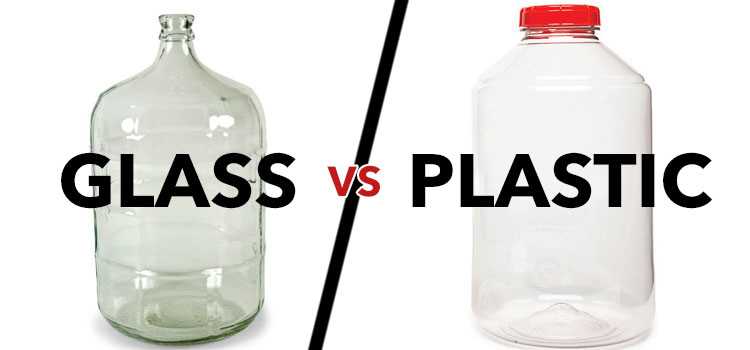
When it comes to choosing between glass and plastic, the decision is not always an easy one. Both materials have their own unique set of advantages and disadvantages, making it important to weigh the pros and cons carefully. Glass has been used for centuries and is known for its elegance, durability, and ability to preserve the taste and quality of the contents it holds. Plastic, on the other hand, is lightweight, affordable, and shatter-resistant.
One of the main benefits of glass is its ability to maintain the taste and purity of whatever it contains. Glass is non-permeable, meaning that it does not absorb odors, flavors, or colors from the contents. This makes it an ideal choice for storing and preserving food and beverages, as it ensures that the taste and quality of the product remain intact. Glass is also easy to clean and does not retain any residual odors or stains.
However, glass is not without its drawbacks. It is heavy and fragile, making it more prone to breakage. This can be a concern especially when transporting or storing glass containers. Glass is also more expensive compared to plastic, which can make it less accessible for some consumers. Additionally, glass takes a longer time to decompose, contributing to environmental concerns.
On the other hand, plastic offers several advantages that make it a popular choice in many industries. Plastic is lightweight and durable, making it easy to transport and handle. It is also shatter-resistant, which reduces the risk of accidents and breakage. Plastic containers are also more affordable compared to glass, making them a cost-effective choice for both manufacturers and consumers. Moreover, plastic is known for its versatility and can be easily molded into different shapes and sizes.
However, plastic also has its downsides. It is known to be less durable than glass and can scratch or crack over time. Plastic containers are also prone to absorbing and retaining odors and stains, which can affect the taste and quality of the contents. Additionally, plastic is not environmentally friendly, as it takes hundreds of years to decompose and contributes to pollution and waste.
In conclusion, the choice between glass and plastic ultimately depends on the specific needs and preferences of the consumer. Glass offers elegance, durability, and taste preservation, but comes with a higher price tag and the risk of breakage. Plastic, on the other hand, is lightweight, affordable, and shatter-resistant, but lacks the same level of durability and can affect the taste of the contents. It is important to weigh the advantages and disadvantages of each material before making a decision.
- Glass vs Plastic: Which is Better?
- Environmental Impact
- Durability and Longevity
- Aesthetics and Presentation
- Glass:
- Plastic:
- Safety and Health Considerations
- Cost and Accessibility
- Use in Different Applications
- Q&A:
- Is glass better for the environment than plastic?
- Which one is more durable, glass or plastic?
- What are the advantages of using glass containers?
- Is plastic a more cost-effective option than glass?
- Can glass be a safer option than plastic?
- Is it better to use glass or plastic for food storage?
Glass vs Plastic: Which is Better?
When it comes to choosing between glass and plastic, there are several factors to consider. Both materials have their advantages and disadvantages, and selecting the right option depends on your specific needs and preferences. Let’s take a closer look at the qualities of glass and plastic to determine which one is the better choice.
| Glass | Plastic |
|---|---|
| Glass is a timeless material that offers a classic and elegant look. It is often associated with high quality and durability. | Plastic is a lightweight and flexible material that is known for its affordability and versatility. It can be easily molded into various shapes and sizes. |
| Glass is nonporous, which means it does not absorb odors or flavors. This makes it ideal for storing food and beverages without altering their taste. | Plastic containers, on the other hand, can sometimes retain the smell or taste of previously stored items, especially if they are not properly cleaned. |
| Glass is recyclable and eco-friendly. It can be reused multiple times without losing its quality, making it a sustainable choice. | Plastic, while also recyclable, is often associated with environmental issues due to its long degradation process. It is important to recycle plastic properly to minimize its impact on the environment. |
| Glass is more resistant to scratches and stains compared to plastic. It is less likely to discolor or become cloudy over time. | Plastic containers are prone to scratches and can become discolored or hazy with repeated use and exposure to heat or sunlight. |
| Glass is considered to be safer for food and beverage storage, as it does not contain any chemicals that can leach into the contents. | Plastic, particularly when exposed to high temperatures, can release harmful chemicals like BPA into the stored items. It is important to choose food-grade plastic containers to minimize this risk. |
In conclusion, both glass and plastic have their distinct advantages and disadvantages. Glass offers a classic and durable option that is nonporous and easily recyclable. Plastic, on the other hand, is lightweight, affordable, and versatile. Ultimately, the better option depends on personal preference, budget, and specific usage requirements. Whether you choose glass or plastic, it is important to use and dispose of them responsibly to reduce environmental impact.
Environmental Impact
When it comes to considering the environmental impact, glass and plastic have different pros and cons.
Glass:
Glass is made from all-natural and abundant materials such as sand, soda ash, and limestone. It is 100% recyclable and can be recycled endlessly without losing its quality. Recycling glass helps to reduce the demand for raw materials, save energy, and reduce carbon emissions. Additionally, glass is inert and does not leach any harmful chemicals into the environment.
However, the production of glass requires a significant amount of energy, and the mining of raw materials can have an impact on the environment. The transportation of glass products can also contribute to carbon emissions due to their weight and fragility.
Plastic:
Plastic is derived from fossil fuels and the production process contributes to greenhouse gas emissions. It takes less energy to produce compared to glass, but it is not as easily recyclable. Plastic can usually only be recycled once or twice before its quality deteriorates, and many types of plastic are not accepted by recycling facilities.
Plastic pollution is a major issue that affects our oceans and wildlife. It takes hundreds of years for plastic to decompose, and during this time, it releases harmful chemicals into the environment. Microplastics also pose a threat to marine life, as they are ingested by organisms and can accumulate in the food chain.
In conclusion,
glass is generally considered to have a lower environmental impact compared to plastic. Its recyclability and inert properties make it a more sustainable option. However, it is important to reduce the overall consumption of single-use packaging materials, regardless of whether they are made of glass or plastic. Opting for reusable containers and alternative materials can further reduce our environmental footprint.
Durability and Longevity

When it comes to durability and longevity, glass is the clear winner. Glass products have a reputation for being strong and sturdy, able to withstand the test of time. Unlike plastic, glass doesn’t easily scratch or get damaged, making it a more reliable option.
Glass also has a longer lifespan compared to plastic. While plastic products can deteriorate over time due to exposure to sunlight and heat, glass remains unaffected by these factors. This means that glass containers can be used and reused for a longer period without losing their quality.
Furthermore, glass is nonporous, which means it doesn’t absorb odors or flavors from food and beverages. This quality ensures that glass containers won’t retain any lingering smells or tastes, making them perfect for storing a variety of items.
When it comes to withstanding extreme temperatures, glass also outperforms plastic. Glass can withstand high heat without warping or melting, making it suitable for use in ovens, microwaves, and dishwashers. Plastic, on the other hand, can melt or release harmful chemicals when exposed to high heat, making it less durable and potentially hazardous.
In terms of overall durability and longevity, glass is the better option. Its strength, resistance to damage, and ability to withstand extreme temperatures make it a reliable and long-lasting choice for various purposes.
Aesthetics and Presentation

When it comes to aesthetics and presentation, both glass and plastic have their own unique qualities and advantages.
Glass:
Glass is often considered a more visually appealing option compared to plastic. Its transparent and glossy nature allows for a clear display of the contents inside, adding an elegant and sophisticated touch to any setting. Whether it’s a glass bottle, a jar, or a vase, glass items can enhance the overall visual appeal of a space. Glass also has a certain timeless quality that can add a touch of class and luxury.
Plastic:
On the other hand, plastic offers a wide range of colors, finishes, and textures, making it a versatile option for different presentation styles. It can be molded into various shapes and sizes, allowing for creative and unique packaging designs. Plastic containers can be transparent or opaque, depending on the desired effect. Plastic is also more lightweight than glass, making it easier to handle and transport.
Ultimately, the choice between glass and plastic for aesthetics and presentation will depend on the specific context and the desired visual impact. Glass may be preferred for its classic and elegant look, while plastic offers more flexibility and variety in terms of design options.
Safety and Health Considerations
When it comes to safety and health considerations, glass has some clear advantages over plastic. One of the main advantages of glass is its non-reactive nature. Unlike plastic, glass does not release any harmful chemicals when exposed to heat or strong cleaning agents. This makes glass a safe choice for storing food and beverages, as it does not contaminate the contents with toxins.
Furthermore, glass is a more durable material than plastic and less prone to scratches, cracks, and other damage. This means that glass containers are less likely to break and spill their contents, reducing the risk of accidents and injuries. In contrast, plastic can easily crack or melt when exposed to high temperatures, posing a potential hazard.
Another safety aspect to consider is the recycling and disposal of glass and plastic. Glass is a highly recyclable material and can be recycled repeatedly without losing its quality. Additionally, glass is inert and does not release harmful substances when it breaks down. Plastic, on the other hand, is harder to recycle and often ends up in landfills or oceans, where it can take hundreds of years to decompose and contribute to environmental pollution.
From a health perspective, glass is considered to be more hygienic than plastic. Glass has a smooth, non-porous surface that is easier to clean and does not harbor bacteria or odors. Plastic, on the other hand, can absorb and retain flavors, odors, and stains, which can be difficult to remove even with thorough cleaning. This can lead to cross-contamination and affect the taste and quality of the stored food or beverage.
In conclusion, when considering safety and health, glass is the better option compared to plastic. Its non-reactive nature, durability, recyclability, and hygienic properties make it a safer and healthier choice for storing food and beverages. So, if you’re concerned about your well-being and the environment, it’s worth considering switching to glass containers.
Cost and Accessibility
When it comes to cost, plastic is generally considered to be the more affordable option. Plastic production is relatively cheap compared to glass, making it readily accessible and widely used in various industries.
Plastic types such as polyethylene terephthalate (PET) and polypropylene (PP) are commonly used in packaging materials, including bottles, containers, and bags. These plastics offer a cost-effective solution for businesses and consumers alike.
On the other hand, glass production requires more energy and resources, making it a more expensive material. The manufacturing process involves melting sand, soda ash, and limestone at high temperatures, which can contribute to higher production costs.
Although glass may be pricier, it offers certain advantages that justify its cost. Glass is durable, long-lasting, and can be recycled multiple times without losing its quality. This recyclability factor makes it an environmentally friendly choice for those willing to invest in a more sustainable option.
In terms of accessibility, plastic is widely available in various forms and sizes, from small disposable items to large containers and packaging materials. Plastic products can be easily purchased at grocery stores, convenience stores, and online retailers.
Glass, however, may not be as readily accessible in certain areas. It is more commonly found in specialized stores or used for specific purposes such as beverage containers or decorative items. Glass products may require more effort to find and purchase, especially if one is looking for a specific design or size.
Overall, plastic is the more cost-effective and easily accessible option for everyday use. However, for those looking to prioritize sustainability and long-term durability, glass can be a worthwhile investment despite its higher cost and limited accessibility.
Use in Different Applications
Glass and plastic both have their own unique advantages and applications in various industries. Understanding where each material excels can help determine the better option for specific uses.
Glass is commonly used in the production of containers such as bottles and jars. It is preferred in these applications due to its impermeability and resistance to chemical reactions. Glass containers are ideal for storing food and beverages as they do not leach chemicals into the contents and can withstand high temperatures without warping or deforming.
On the other hand, plastic is lightweight, durable, and cost-effective. It is widely utilized in industries such as packaging, automotive, and electronics. Plastic containers and packaging provide a convenient and lightweight solution for storing and transporting various goods. Plastic is also a preferred material for disposable food packaging and cutlery due to its affordability and ease of mass production.
When it comes to household use, glass and plastic have their own advantages. Glass containers are commonly used for storing leftovers, as they are easy to clean, do not retain odors, and are microwave-safe. Plastic containers are popular for their lightweight and shatter-resistant properties, making them suitable for everyday use and on-the-go purposes.
| Use | Glass | Plastic |
|---|---|---|
| Food and Beverage Containers | ✓ | ✓ |
| Packaging | ✓ | ✓ |
| Automotive | ✗ | ✓ |
| Electronics | ✗ | ✓ |
| Disposable Food Packaging | ✗ | ✓ |
| Household Use | ✓ | ✓ |
In conclusion, glass and plastic are both valuable materials with their own unique applications. The choice between the two ultimately depends on the specific use and desired properties. Whether it’s for containing food and beverages, packaging, or household use, understanding the strengths of each material can help in making an informed decision.
Q&A:
Is glass better for the environment than plastic?
Glass is considered to be a more environmentally friendly option compared to plastic. It is made from natural materials such as sand, soda ash, and limestone, which are abundant and renewable. Glass is also 100% recyclable and can be recycled indefinitely without losing its quality.
Which one is more durable, glass or plastic?
Glass is generally more durable than plastic. It is resistant to scratches and stains, and it does not deteriorate over time. Plastic, on the other hand, can easily scratch and wear out, and some types of plastic may degrade or leach harmful chemicals into the contents it holds.
What are the advantages of using glass containers?
Using glass containers has several advantages. Glass is non-porous, meaning it does not absorb odors or flavors from the food or beverage it holds. It is also easy to clean and can be safely used in the microwave, oven, and freezer. Glass containers are aesthetically pleasing and are often used for serving and storing food or drinks.
Is plastic a more cost-effective option than glass?
Plastic is generally more cost-effective than glass. The production of plastic containers requires less energy and resources compared to glass. Plastic is also lighter and less likely to break, which reduces transportation costs. However, it’s important to consider the long-term costs and environmental impact, as plastic is not biodegradable and often ends up in landfills or oceans.
Can glass be a safer option than plastic?
Glass can be considered a safer option than plastic in some cases. Unlike certain types of plastic, glass does not contain harmful chemicals such as BPA or phthalates that can leach into the food or drink it holds. Glass is also heat-resistant, which makes it suitable for hot beverages or for use in the oven. However, it’s important to handle glass carefully to avoid breakage and potential injuries.
Is it better to use glass or plastic for food storage?
Both glass and plastic have their advantages and disadvantages for food storage. Glass is inert and won’t leach chemicals into your food, but it’s heavier and more prone to breakage. Plastic is lightweight and durable, but it can absorb odors and stains over time. Ultimately, it depends on your personal preferences and needs.